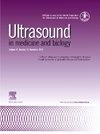Ultrasound Image Velocimetry for High Spatiotemporal Resolution Blood Flow Velocity Field Mapping in Mice
IF 2.4
3区 医学
Q2 ACOUSTICS
引用次数: 0
Abstract
Objective
Abnormal hemodynamics is thought to play an essential role in the development of cardiovascular diseases. Mouse models are widely used for elucidating the underlying mechanisms; however, their small size and high heart rates make it difficult to perform quantitative flow velocity field mapping with sufficient temporal resolution. Our objective was to develop a noninvasive method for quantitative flow field mapping in mice based on speckle-tracking from high-frequency ultrasound B-mode imaging.
Methods
Ultrasound ECG-gated kilohertz visualization (EKV) was performed on a mouse-aorta-sized tubular flow phantom at frame rates up to 10,000 fps. Unexpected velocity underestimations were elucidated by simulating EKV reconstruction and performing ultrasound image velocimetry (UIV) in silico. A technique for error correction was developed and validated in vitro, and demonstrated in vivo.
Results
In flow phantoms, EKV-UIV underestimated velocity in the beam lateral direction by 50%–70%. This was attributed to loss of speckle contiguity owing to EKV's retrospective strip-based reconstruction of the two-dimensional B-mode image. The proposed correction technique reduced the errors to <10% by accounting only for speckle movement within each image strip. A preliminary in vivo study showed that vortex shapes and near-wall expansion movement inside a mouse left ventricle were more aligned with physical expectations after correction.
Conclusion
A novel technique was developed to quantitatively map blood flow with high spatiotemporal resolution. Further optimization will enable longitudinal studies in mice to gain insights on the role of local hemodynamic forces in the development of cardiovascular diseases.
超声波图像测速仪用于绘制小鼠高时空分辨率血流速度场图
目的:血液动力学异常被认为在心血管疾病的发生发展中起着重要作用。小鼠模型被广泛用于阐明潜在的机制;然而,它们的体积小,心率高,使得在足够的时间分辨率下进行定量流速场映射变得困难。我们的目标是开发一种基于高频超声b型成像斑点跟踪的无创小鼠流场定量测绘方法。方法:超声心电图门控千赫兹可视化(EKV)对小鼠主动脉大小的管状血流幻影以高达10,000 fps的帧率进行。通过模拟EKV重建和进行超声图像测速(UIV),阐明了意想不到的速度低估。一种误差校正技术在体外被开发和验证,并在体内被证明。结果:在流动幻象中,ekv - uv在光束横向方向上低估了50% ~ 70%的速度。这是由于EKV对二维b模式图像进行回顾性条带重建,导致散斑邻近度的损失。结论:开发了一种具有高时空分辨率的定量血流图的新技术。进一步的优化将使小鼠纵向研究能够深入了解局部血流动力学力在心血管疾病发展中的作用。
本文章由计算机程序翻译,如有差异,请以英文原文为准。
求助全文
约1分钟内获得全文
求助全文
来源期刊
CiteScore
6.20
自引率
6.90%
发文量
325
审稿时长
70 days
期刊介绍:
Ultrasound in Medicine and Biology is the official journal of the World Federation for Ultrasound in Medicine and Biology. The journal publishes original contributions that demonstrate a novel application of an existing ultrasound technology in clinical diagnostic, interventional and therapeutic applications, new and improved clinical techniques, the physics, engineering and technology of ultrasound in medicine and biology, and the interactions between ultrasound and biological systems, including bioeffects. Papers that simply utilize standard diagnostic ultrasound as a measuring tool will be considered out of scope. Extended critical reviews of subjects of contemporary interest in the field are also published, in addition to occasional editorial articles, clinical and technical notes, book reviews, letters to the editor and a calendar of forthcoming meetings. It is the aim of the journal fully to meet the information and publication requirements of the clinicians, scientists, engineers and other professionals who constitute the biomedical ultrasonic community.

 求助内容:
求助内容: 应助结果提醒方式:
应助结果提醒方式:


